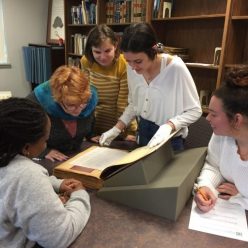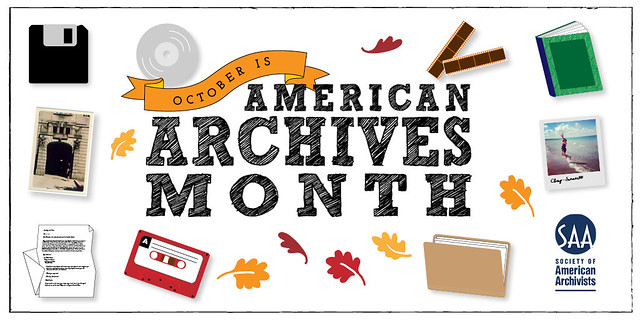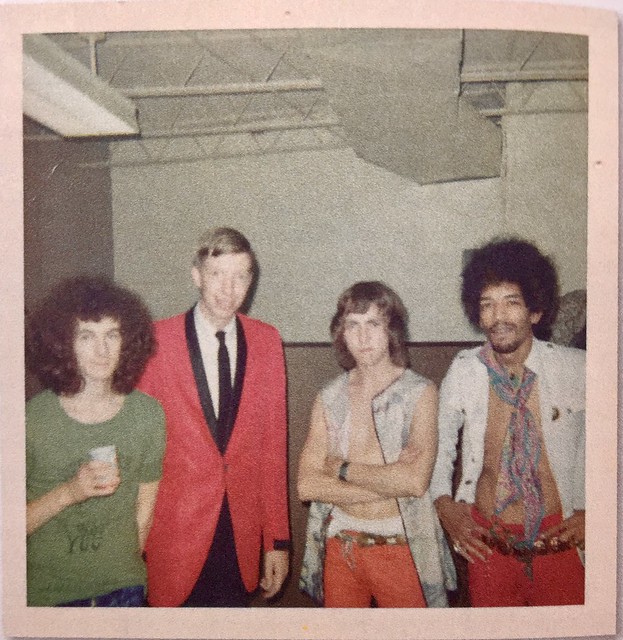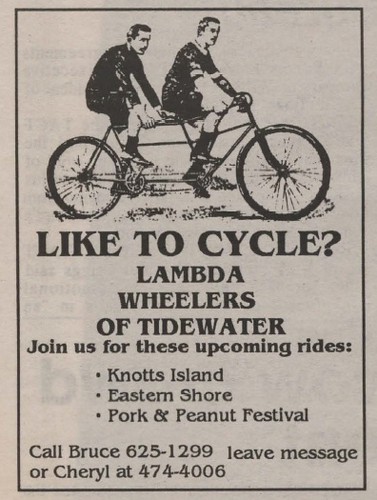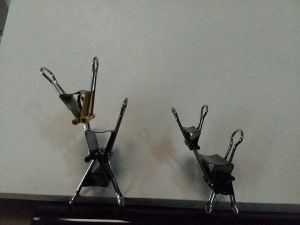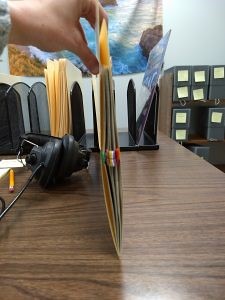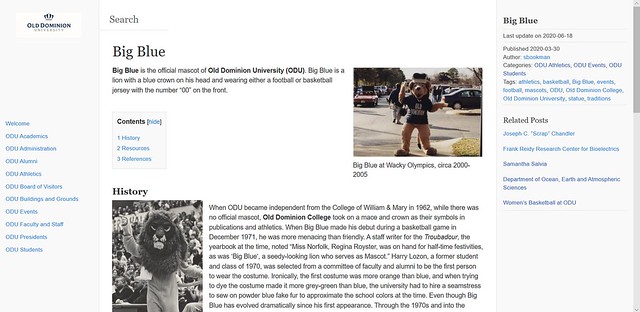By Special Collections Assistant Mel Frizzell
With the holidays coming up, I decided to change pace from my usual blog posts to write about finding recipes and cookbooks in the archives. I can’t say that I’m that much of a cook myself. Back at the beginning of this pandemic when friends and co-workers were sharing all their great cooking and baking photos on social media, I was pretty proud of myself when I made instant pudding – pour pudding mix into bowl, add half cup of milk, stir vigorously with a whisk, and chill at least 30 minutes. When I wanted to get fancy, I made it banana pudding, threw in some sliced bananas, and haphazardly placed some vanilla wafers on top. If it takes more than two pots to cook or mixing a multitude of ingredients from scratch, I’m likely to leave well alone.
While I’m not much of a cook, that doesn’t stop me from being fascinated by recipes and cookbooks. I have dozens of cookbooks at home (many that caught my attention in the checkout line of the grocery store) and a number of recipes I’ve printed from the internet with good intentions. Occasionally, I’ll pull these out, wipe off the dust, and imagine how great it would be to cook something from them – only to decide upon further reflection that maybe I should just get takeout.
In my years working in the archives, I’ll occasionally stumble upon a recipe or even a cookbook in a collection I’m working on. Cookbooks and recipes in collections include the personal (or at least personally collected) recipes of the donor, compilation cookbooks created by organizations (often created for fundraising), and sometimes official cookbooks published for mass consumption (though these are often removed unless they are specifically related to the donor or their collection).
Recipes and cookbooks in the archives can provide cultural and historical context. For example, in our Special Collections in the ODU Library we have a cookbook created for the Clan MacLeod Society of the USA. This is a Scottish society for those of the MacLeod lineage. You wouldn’t at all be surprised to know that one of the recipes in the book is for “Haggis.” What might surprise you are non-Scottish recipes like “Australian Bacon and Eggs” or “Hawaiian Chicken.” But it is a compilation cookbook and most folks don’t limit their choices in food to one culture, even if they are proud of their heritage.
As for historical context, certain ingredients and food trends might be related to a certain period of time. How many of us in the 21st century still cook with lard? How many of us are watching our fat or sodium intake? Do we subscribe to a dieting trend – Paleo, Keto, Atkins, Slow Carb, etc.? Various trends and fads of the time might influence what you find in an old cookbook.
The preface to the 1993 reprint of the Unitarian Church’s “Your Bazaar Cookbook” from 1958 states this idea well.
This 1958 Unitarian Church Cook Book has been reproduced just as it was written.
You might find it dated. The recipes were not selected for “low cholesterol” or “low sodium.” You will find ingredients that are not familiar to us today (lard, for instance).
Also, the quotes, “Mental Spices!”, are not the ones we’d pick today.
However, we present it to you, almost as is, with grateful appreciation for those earlier “UU’s” who were then only “U’s” but who were on the same quest we are on in 1993.
“The Liberal Seasonings” Cookbook Crew
Norfolk, Virginia, November, 1993
The Unitarian Church cookbook is a perfect example of a compilation cookbook created for an organization. “Your Bazaar Cookbook” was reprinted at the same time the Church decided to compile and print a contemporary cookbook titled “Liberal Seasonings.” The older cookbook contained sections titled “Mental Spices” and the 1993 cookbook continued this tradition with sections titled “Food for Thought.” The idea was that the cookbook contained not just recipes of food for the body, but also recipes for life and the soul.
Prefaces, forwards, and other sections in these cookbooks can provide additional historical context, and sometimes humor. “Your Bazaar Cookbook” has this piece of humor under its “Mental Spice” headings “Salmon is a fish that lurks in a can and only comes out when unexpected company arrives.” The newer “Liberal Seasonings Cookbook” under its “Food for Thought” provides this definition from Abrose Bierce: “Deliberation. The act of examining one’s bread to determine which side it is buttered on.” I thought the preface to the Clan MacLeod Family Cookbook especially entertaining. Rather than quoting it directly, I have included an image of the page here.
Years ago, I remember seeing a cookbook devoted entirely to gelatin molds. It was fascinating to see the things they’d throw into Jell-O from the 1930s into at least into the 1970s. Historically speaking, gelatin didn’t become mainstream until refrigeration became mainstream in the early 20th century, though it has been around in some form since Victorian times. Today, we mostly think of Jell-O as dessert, but back then gelatin molds could be anything from a dessert to a main course. While I couldn’t identify that exact cookbook when writing this article*, I did find examples of gelatin mold recipes in other cookbooks in our collections. The Creative Cookery Recipe Book in the Edythe Harrison Papers included various gelatin molds including: a Salmon or Haddock Mold, an “Out of this World” Tuna Mold, a Horseradish Ring, and a Crisp Cucumber Mold. Betty Howell’s recipes include a gelatin mold recipe for Cole Slaw Souffle Salad. The Cook Family Papers contains an undated Jell-O recipe book that contains mostly desserts.
Cookbooks and recipes in our Special Collections at ODU include: the Clan MacLeod Family Cookbook (undated); the Unitarian Church “Your Bazaar Cook Book (1958) and also their “Liberal Seasonings Cookbook (1993); the 1975 Creative Cookery recipe book created by the Norfolk and Virginia Beach Chapters of the Women’s American ORT (this cookbook includes sections on Jewish traditional and Passover meals among others); a 1950 personal recipe for Shrimp Lamaze from Eleanor Bader; a small collection of personal recipes from Betty Howell including the aforementioned Cole Slaw Souffle Salad; various recipes in the James Washington Singleton Papers including a historical 1785 “Slave Recipe for Beer” and various recipes (both handwritten and clipped from newspapers) from the late 19th / early 20th centuries; and the Whittle Family’s recipe for Rum Punch in the Warren Spencer Papers. The Cook Family Papers includes a 1907 recipe book titled “Choice Recipes by Miss Parloa and other Noted Teachers;” a 1907 Recipe Book by Walter Baker & Co. Ltd. Manufacturer of Cocoa & Chocolate Preparations, Dorchester, Mass. which contains all sorts of chocolate dessert recipes; an undated (early 20th century) recipe book for making ice cream and “frozen dainties” using the “Auto Vacuum Freezer” device; an undated recipe book for using “Jell-O Ice Cream Powder;” “A Selection of Old and New Recipes for using Amber Brand Deviled Smithfield Ham” (undated) created by The Smithfield Ham & Products Company, Inc., Smithfield, Virginia; and “A Few Recipes from Virginia” compiled by the Hampton Chapter of the Daughters of the American Revolution. This last recipe book is also not dated, but mentions the Jamestown Exposition which took place in 1907.
So if you’re looking for a historical recipe for this upcoming Thanksgiving, just want to see what people ate back in the day, or want to get adventurous with Jell-O, consider searching for recipes in the archives.
* It’s possible this gelatin cookbook may have been the Jell-O recipe book from the Cook Family Papers, but I remember a larger cookbook with more main course and side type recipes. This one is mostly desserts.
Images: Clan MacLeod Cookbook preface, and “Out of this World” Tuna Mold (from Edythe Harrison’s Creative Cookery” recipe book).
‘Under the Sea Salad” https://commons.wikimedia.org/wiki/File:Illustrated_recipe_for_%27Under_the_Sea_Salad%27_Wellcome_L0072306.jpg
References:
Clan MacLeod Family Cookbook, Box 80, Folder 9, Clan MacLeod Society USA Records, Special Collections and University Archives, Patricia W. and J. Douglas Perry Library, Old Dominion University Libraries, Norfolk, VA 23529.
Your Bazaar Cookbook 1958 (1993 reprint), Box 61, Folder 9, Unitarian Universalist Church of Norfolk, Special Collections and University Archives, Patricia W. and J. Douglas Perry Library, Old Dominion University Libraries, Norfolk, VA 23529.
Liberal Seasonings Cookbook 1993, Box 61, Folder 9, Unitarian Universalist Church of Norfolk, Special Collections and University Archives, Patricia W. and J. Douglas Perry Library, Old Dominion University Libraries, Norfolk, VA 23529.
Rum Punch Recipe from Whittle Family, Box 1, Folder 36. Warren Spencer Papers, Special Collections and University Archives, Patricia W. and J. Douglas Perry Library, Old Dominion University Libraries, Norfolk, VA 23529.
Betty Howell’s Recipes, Box 282, Folder 8, Henry Howell Papers, Special Collections and University Archives, Patricia W. and J. Douglas Perry Library, Old Dominion University Libraries, Norfolk, VA 23529.
Recipes, Box 4, Folder 19, Eleanor Bader Papers, Special Collections and University Archives, Patricia W. and J. Douglas Perry Library, Old Dominion University Libraries, Norfolk, VA 23529.
Creative Cookery, Box 74, Folder 18, Edythe Harrison Papers, Special Collections and University Archives, Patricia W. and J. Douglas Perry Library, Old Dominion University Libraries, Norfolk, VA 23529.
Slave Recipe for Beer, Box 28, Folder 22, James Washington Singleton Papers, Special Collections and University Archives, Patricia W. and J. Douglas Perry Library, Old Dominion University Libraries, Norfolk, VA 23529.
Recipes, Box 28, Folders 1-5, James Washington Singleton Papers, Special Collections and University Archives, Patricia W. and J. Douglas Perry Library, Old Dominion University Libraries, Norfolk, VA 23529.
“Choice Recipes by Miss Parloa and other Noted Teachers”, Box 5, Folder 3, Cook Family papers, Special Collections and University Archives, Patricia W. and J. Douglas Perry Library, Old Dominion University Libraries, Norfolk, VA 23529.
Walter Baker & Co. Ltd. Manufacturer of Cocoa & Chocolate Preparations, Dorchester, Mass., Box 5, Folder 3, Cook Family papers, Special Collections and University Archives, Patricia W. and J. Douglas Perry Library, Old Dominion University Libraries, Norfolk, VA 23529.
Auto Vacuum Frozen Dainties Ice Cream maker and freezer recipes using the “Auto Vacuum Freezer”, Box 8, Folder 3, Cook Family papers, Special Collections and University Archives, Patricia W. and J. Douglas Perry Library, Old Dominion University Libraries, Norfolk, VA 23529.
“Jell-O Ice Cream Powder”, Box 8, Folder 3, Cook Family papers, Special Collections and University Archives, Patricia W. and J. Douglas Perry Library, Old Dominion University Libraries, Norfolk, VA 23529.
“A Selection of Old and New Recipes for using Amber Brand Deviled Smithfield Ham”, Box 8, Folder 3, Cook Family papers, Special Collections and University Archives, Patricia W. and J. Douglas Perry Library, Old Dominion University Libraries, Norfolk, VA 23529.
“A Few Recipes from Virginia”, Box 5, Folder 7, Cook Family papers, Special Collections and University Archives, Patricia W. and J. Douglas Perry Library, Old Dominion University Libraries, Norfolk, VA 23529.
Recipes, Box 12, Folder 30, Cook Family papers, Special Collections and University Archives, Patricia W. and J. Douglas Perry Library, Old Dominion University Libraries, Norfolk, VA 23529.
Wikipedia, ‘Jell-O’: https://en.wikipedia.org/wiki/Jell-O
